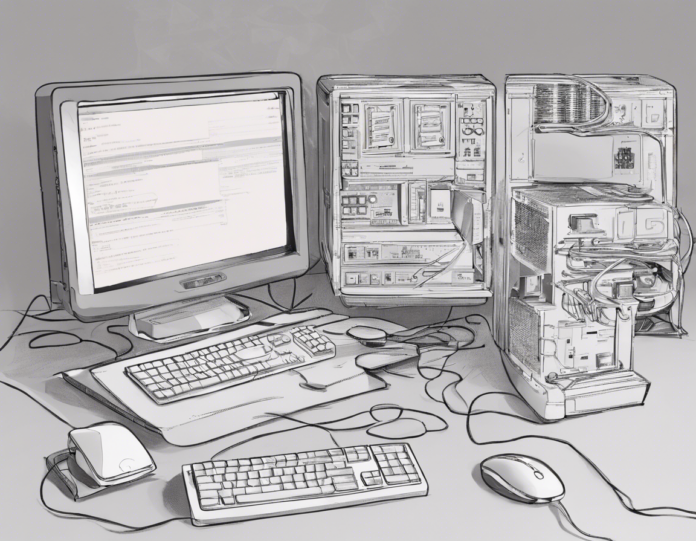Introduction
Starting a computer might seem like a straightforward task for many, but for beginners, it can be a daunting experience. This guide aims to simplify the process of starting a computer, from the physical setup to powering on and navigating through the operating system. By following these step-by-step instructions, even the most inexperienced user can confidently power up their computer and begin their digital journey.
Setting Up Your Computer
Before starting your computer, ensure that you have all the necessary components:
– Computer tower or laptop
– Monitor
– Keyboard and mouse
– Power cables
– Internet connection (if required)
- Physical Setup:
- Place your computer tower on a stable surface or open your laptop on a flat workspace.
- Connect the monitor to the computer using the appropriate cable (VGA, HDMI, DisplayPort, etc.).
- Plug in the keyboard and mouse to the USB ports on the computer.
- Connect the power cable to the computer and plug it into a power outlet.
-
If you are using a desktop computer, connect the monitor to a power source and turn it on.
-
Powering On:
- Press the power button located on the computer tower or the laptop.
- Wait for the computer to boot up. You will see the manufacturer’s logo or a loading screen.
- Once the operating system (e.g., Windows, macOS, Linux) loads, you will be prompted to log in or create an account.
Navigating Through the Operating System
- Logging In:
-
Enter your username and password if prompted. If you are using the computer for the first time, follow the on-screen instructions to set up a new account.
-
Desktop Interface:
- The desktop is the main screen of your computer. Here you will find icons, shortcuts, and the taskbar.
- Icons represent programs or files. Double-click on an icon to open it.
-
The taskbar at the bottom of the screen contains the Start menu (Windows), applications (macOS), or the dock (macOS).
-
Starting Programs:
- To open a program, click on its icon on the desktop or use the Start menu (Windows) or Applications folder (macOS).
-
Some commonly used programs include web browsers (e.g., Chrome, Firefox), word processors (e.g., Microsoft Word, Pages), and media players (e.g., VLC, iTunes).
-
Internet Connection:
- If you need to connect to the internet, click on the network icon on the taskbar (Windows) or the Wi-Fi symbol on the menu bar (macOS).
- Select the available Wi-Fi network and enter the password to connect.
Customizing Your Computer
- Personalization:
- You can customize your computer by changing the desktop background, screen saver, and theme.
-
Right-click on the desktop and select “Personalize” (Windows) or go to System Preferences > Desktop & Screen Saver (macOS).
-
Settings:
- Access the settings menu to adjust display settings, sound preferences, and other system configurations.
-
Click on the Start menu > Settings (Windows) or go to System Preferences (macOS).
-
Installing Applications:
- Visit the respective app store for your operating system (e.g., Microsoft Store, App Store) to download and install new applications.
Troubleshooting
- Restart Your Computer:
-
If your computer is frozen or unresponsive, try restarting it by clicking on the Start menu > Restart (Windows) or pressing Ctrl + Command + Power button (macOS).
-
Check Connections:
-
Ensure all cables are securely connected to the computer and power source. Loose connections can cause display or power issues.
-
Update Software:
- Regularly update your operating system and applications to ensure optimal performance and security.
Frequently Asked Questions (FAQs)
- Q: My computer is not turning on. What should I do?
-
A: Check the power source and cables to ensure everything is properly connected. Try plugging the computer into a different outlet to rule out power issues.
-
Q: How do I create a password for my account on the computer?
-
A: During the initial setup or when prompted to create an account, you will have the option to set up a password for your user account.
-
Q: What is the difference between shutting down and restarting my computer?
-
A: Shutting down completely powers off the computer, while restarting reboots the system without fully powering down.
-
Q: Can I connect my computer to a wireless network?
-
A: Yes, you can connect your computer to a Wi-Fi network by selecting the network from the available list and entering the password.
-
Q: How do I install new software on my computer?
- A: Visit the app store for your operating system or download software from the internet. Follow the installation instructions provided by the software.
In conclusion, starting a computer is a fundamental skill in today’s digital age. By following the steps outlined in this guide and familiarizing yourself with the basics of navigating through the operating system, you can confidently begin your computer journey. Remember to explore and experiment with different features to enhance your computing experience.

